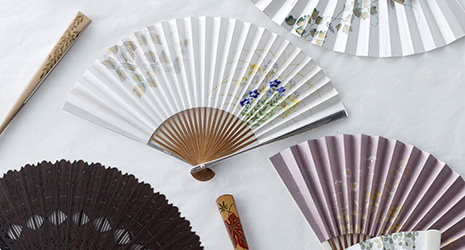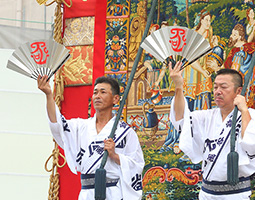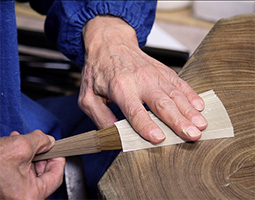INDEX
- English
- 日本語

Kyo-sensu folding fans - English
- 日本語

A Kyo-sensu folding fan made in collaboration with Kyoto-based nihonga (Japanese-style painting) artist Sadaie Ayuko

Hiogi fans are an essential feature of traditional court attire 
Ondotori float directors at the Gion festival holding sensu fans 
Miyawaki Baisenan Co., Ltd. is passing on traditional skills by training highly proficient craftspeople
August 2021
Kyoto Folding Fans: Beauty and Utility

Since long ago, folding fans have been used in Japan’s hot humid summers to create a gentle cooling breeze. Among these fans is the Kyo-sensu (Kyoto folding fan), which is characterized by its delicate construction.

A folding fan, or sensu, is made of paper glued onto a bamboo or wooden frame and is small and light enough to fold and slip into a bag or purse and carry around. When you want to cool down you can simply take it out and open it to create a gentle breeze. The high portability and convenience of the sensu has led to its enduring presence in Japan through the ages as a practical summer accessory.
Sensu are produced in a number of Japanese regions, and those produced in Kyoto are called Kyo-sensu. As well as having an appealing tactile quality, smooth opening mechanism, and ease of use, Kyo-sensu are decorated with colorful, original hand-painted designs created in past ages, and are thus known for their seamless fusion of beauty and utility. Minami Tadamasa, the eighth-generation head and president of Miyawaki Baisenan Co., Ltd., established in 1823, and president of the Kyoto Folding Fan & Round Fan Association of Commerce and Industry, explains the characteristics of Kyo-sensu as follows.
“The term ‘Kyo-sensu’ refers to products made by craftsmen in Kyoto Prefecture using materials from Kyoto and the surrounding areas. The tip of the Kyo-sensu becomes thinner when closed, and the preferred designs are hand-painted motifs depicting beauties of nature that evoke the seasons, such as dragonflies.”

The original sensu are said to have derived from wooden slats called mokkan that were bound and used to record information. The hiogi fan made from slats of hinoki, or Japanese cypress, was derived from that shape. The oldest existing hiogi fan is inscribed with “the first year of the Genkei period” (877). From the Heian period (late eighth to late twelfth century), it was the correct form for women to hold a hiogi fan when they wore the layered junihitoe robe, the formal attire of women at the Imperial Court. According to the literature, the sensu made of paper were first made in around the tenth century and exported to China in around the thirteenth century. These fans later found their way to Europe, where they evolved into Western folding fans.
Today, some sensu are made from silk cloth and thinly shaved fragrant wood such as sandalwood, but Kyo-sensu are typically produced by inserting a skeleton of thin bamboo strips into a sheet of paper. Production actually involves eighty-seven processes, from shaving the bamboo to processing the paper and through to final assembly of the sensu, entailing a high degree of division of labor between artisans.
Says Minami, “Nowadays, sensu are mainly used for practical, everyday purposes, but they were originally used for such things as court ceremonies. Even now, the sensu is an essential item for rituals and solemn occasions. ”

In Japan, the shape of an open fan is referred to as sue-hirogari, literally “spreading out like an open fan.” This shape is widely considered to be auspicious, with the gradual widening of the fan toward the end signifying increasing prosperity. As such, the sensu is an indispensable accessory for the bride and groom when holding a wedding ceremony dressed in kimono, traditional Japanese attire.
The sensu is also a feature of the Gion festival in Kyoto, a month-long festival held in July. The highlight of the festival is the Yamahoko procession, when thirty-three spectacular yamahoko floats are pulled through the streets of Kyoto by 40 to 50 people led by ondotori float directors holding sensu.
In recent years, young people have also been rediscovering sensu. Miyawaki Baisenan too is collaborating with fashion brands to create sensu for the younger generation. “As well as bringing in new ideas, we see it as our duty to train craftsmen in order to ensure that the skills are passed down to the next generation,” says Minami.

With a history and tradition of over one thousand years, Kyo-sensu continue to add gorgeous color to Japanese summers, while epitomizing both beauty and utility.

